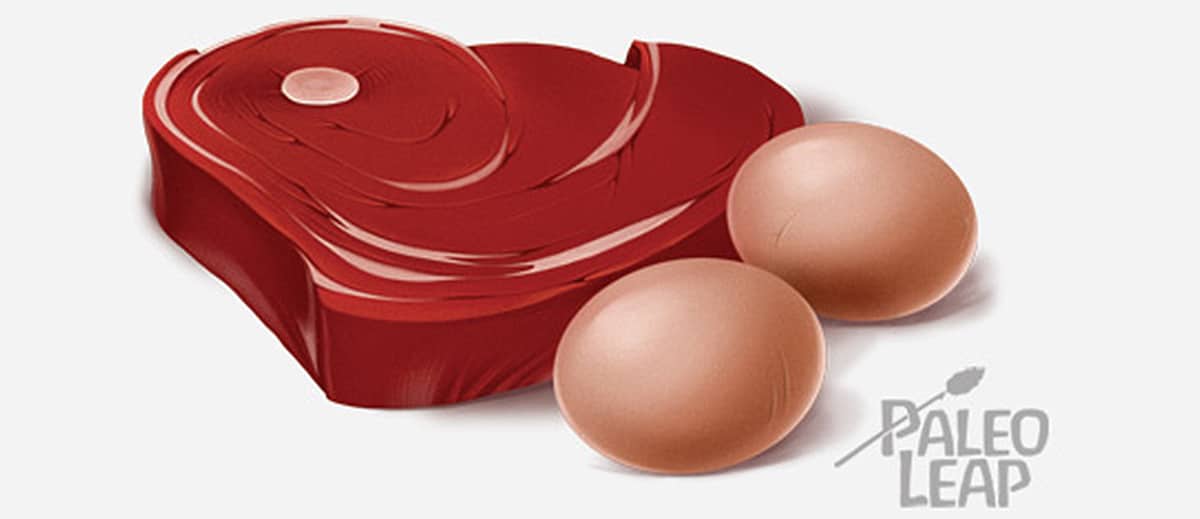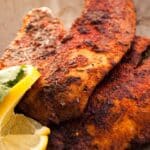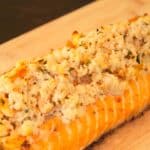Many vegetarians will argue that the majority of mammals eat a vegetarian diet and fare very well. (They haven’t taken into account wolves, coyotes, foxes, and all other dogs, badgers, bears, big (and small) cats, the civet family (mongooses, genets, and meerkats), weasels and wolverines, martens, sea and river otters, seals, toothed whales (sperm and killer whales, orcas, porpoises, and other dolphins), and the tiny carnivorous tarsier monkey, just to name a few). Even wild chimps occasionally eat meat when they can kill a sick or injured animal).
Vegetarians will tell you that gorillas can lift 10 times their weight on a diet composed almost entirely of plants, while even the strongest among humans can only lift 3 times their weight, but that has more to do with upper body and limb size, and the shoulder structure of apes than it does their diet.
What people who espouse vegetarianism haven’t figured out is that the gorilla’s digestive anatomy is much different than ours and that gorillas, like all other mammals, really eat a high fat diet.
Gorillas and other herbivores have developed big guts (protruding bellies) to accommodate their larger and longer colon (as compared to humans). They need it to provide room for enough bacteria to ferment plant fibers and cellulose which produces short-chain fatty acids as a byproduct, and they must eat all day long, as much as 50 pounds of plants a day for this to work. The end product of all this eating is fat. In fact whether they’re omnivores, herbivores, or carnivores, the end source of energy for all animals is fatty acids.
- Herbivores have very specialized guts, sometimes with more than one stomach, and have to eat continuously for this complex fermentation system to work.
- Factory farmed cattle whose diets consist of grains rather than their natural diets of foraged materials have continuous digestive problems.
Gorillas in captivity (zoos) that are fed calorie-dense processed grains, starch and sugar develop obesity and heart disease from a diet that’s not like the diets of their wild counterparts.
- In one experiment done by Case Western Reserve University, the diets of zoo gorillas were switched to vegetables, including greens and lettuces, about 10 pounds a day. (2)
- They spent 75% of their time foraging for the vegetables that were scattered around their pen, took in twice as many calories, and lost an average of 65 pounds apiece because they were eating a diet that worked to the evolutionary configuration of their digestive systems.
- These apes also dropped a habit only found in zoo apes. They stopped vomiting and re-eating their food, perhaps in an attempt to lengthen the fermentation process.
The human digestive system can’t digest cellulose and has a very limited ability to change plant fiber to fatty acids. We have neither the time nor the digestive capacity to consume the weight in plants that would be required to begin fermenting plant fibers to fatty acids, and our bodies are just not designed to do so.
Fat throughout man’s history

Prehistorical humans faced a glaciation period where we had to eat a diet composed exclusively of animal products. We can correlate the time when our brains started getting bigger with the time our diet was almost exclusively composed of animals.
- We have descriptive evidence in cave paintings that depict animals, often with men hunting them.
- Fossilized excrements have been found with traces of bones and egg shells, but no seeds. This is important because seeds don’t get digested and always end up in the stools of mammals, which suggests we probably didn’t eat any plant matter at that time.
According to premier paleoanthropologist Leslie Aiello, a thirty year professor at University College, London who makes a study of fossil records from early hominids, isotope ecology offers evidence to how early savannah peoples ate.
“In evolutionary terms, big human brains — with enormous energy requirements — are inversely proportional to gut size”, a theory known as Expensive Tissue Hypothesis (ETH). (3) Both brain and gut tissue require a lot of energy to produce, so as brains (and the craniums that housed them) grew, the body had to make a trade-off and guts began to shrink.
In other words, the only way we were able to develop such big brains that take up to 25% of our total available energy was by getting a smaller gut.
Aiello concludes, “there was a definite dietary change to foods of high nutritional value [that were] easy to digest. Whatever was happening here, homo erectus got it right.”
Humans were able to develop a smaller gut is by eating a more nutrient dense diet from meat and fat. The fat found in bone marrow and brain is some of the most nutrient and calorically rich source of food available on the planet, and once man developed tools to get to the precious brain and marrow, we were able to get to this amazingly rich source of food.
Some experts believe that meat-eating only had a secondary effect on the development of a large brain in humans.
Neurons are responsible for all communication from the brain to the rest of the body, and they rely on glucose, which must remain in constant supply, to do so. Neurons are constantly active even when we’re asleep, so glucose is often used up quickly.
This theory holds that once man began eating meat, which was a greater source of protein and calories for performing vital bodily functions, it left more glucose (carbohydrates) available for the brain, thus allowing it to grow.
The human brain is composed of nearly 60% fat, with fatty acids that are critical in facilitating brain performance. Omega 3s (EPA and DHA) in particular are necessary for proper brain development as we know it today, and there are very few vegan sources that are high in this critical component. They include seaweed, flax, chia, and hemp seeds, with other vegan sources quite low on the list. This would naturally suggest that the human brain began to grow when we started eating animals with their fatty components on a regular basis.
So while glucose may be the mainstay that “feeds” neurological processes, neuronal cells are surrounded by phospholipids (fatty acids) that provide a barrier and only let in certain molecules, including those that cause respiration or the synthesis of food into energy. (5)
The most likely scenario is that plants were sufficient for basic survival but not much more. Meat gave man a great boost, and the cooking process upped the energy stakes to make our brains what they are today. (4)
- Cooking allowed a greater net energy from all food, very important for getting a nutrient-dense and easily digestible diet that permitted us to further reduce the size of our gut.
- Having saturated fat and cooked meat as the basis of our diet permitted us to need less and less gut size and develop the huge brain we enjoy today.
- Meat-eating animals including human cultures instinctively went for the fatty parts of an animal first. They usually had to go to great lengths extending a tremendous amount of energy to hunt down and get to the fatty brain and marrow of animals. The return had to be worth the investment.
Not surprisingly, studies have demonstrated that our brains are now getting smaller. One study even showed that vegetarians lost 5% of their brain size over a five year period. That’s a huge change by evolutionary standards!
What is fat?
Fats, known chemically as the molecules triesters of glycerol (triglycerides) and fatty acids, are one of the three macronutrients (fats, carbohydrates, proteins). Fat is vital for body processes such as digestion, transport, conversion, and energy extraction. It’s our body’s primary source for stored energy, and by weight, it contains three times the amount of energy provided by glucose which must be provided to the brain in a continuous supply throughout the day. We can’t survive without fat.
Fat is necessary for many reasons.
- Digestion - Fat is not soluble in blood, so bile acids produced from cholesterol in the liver emulsify it along the way to make it bioavailable. It stores the fat soluble vitamins A, D, E, and K in the liver and fatty tissues. Because fat needs to be broken down through multiple processes that include the stomach, duodenum, liver, gall bladder, pancreas, and small intestine, it stays around for a long time and keeps you satiated.
- Transport - Fat is part of every cell membrane in the body. It helps transport nutrients and metabolites across cell membranes.
- Conversion - Your body utilizes fat for everything from activating hormones to building immune function.
- Energy extraction - Between meals or when glucose is not available, triglycerides are broken down and metabolized for energy, which in times of great need, the brain’s neurons can utilize.
- Nervous system - The axon is the part of a nerve (neuron) that transmits electrical signals from the brain throughout the body to initiate all functions. The axon’s protective coating is the myelin sheath and is made of 80% lipids (fats) that must be provided by the diet.
What‘s the difference between brown fat and white fat?
Brown fat is abundant with mitochondria, which give it the rich brownish red color. Mitochondria’s function is respiration and energy production. It produces ATP (adenosine triphosphate) by using the energy stored in food, in this case, fat. Brown fat burns calorie-intense lipids, releases stored energy and creates heat. (1)
White fat stores lipids but doesn’t burn them, creating unhealthy belly fat. This is the type of fat that makes people “fat”. When too much white fat is accumulated, we gain the wrong kind of weight. Subcutaneous fat like the kind that’s been stored around the belly, thighs, or butt can’t be burned without new dietary fat, which triggers fat-burning channels through the liver.
Eating too many calories from fast-burning carbohydrates can put you over your weight, too, and will probably do so more quickly than fats. Any excess glycogen (which is made from excess glucose) that can’t be reserved for energy is converted to triglycerides and stored.
Saturated fat, a critical component of life
Is it any wonder that the fat that composes our own bone marrow and most of our brain, saturated fat, should also be the fat that we consume? Saturated fat has been demonized mainly because most sources are also high in cholesterol. Cholesterol is one of the most important constituents of life. Your body produces it and can regulate its levels whether it’s synthesizing its own cholesterol or cholesterol from dietary sources. Every cell needs it, the brain contains large amounts and cholesterol is the precursor to many of the most important hormones. In fact, a high saturated fat intake has been shown to reduce what we call the bad cholesterol, small particle LDL, and raise what’s called the good cholesterol, HDL. LDL and HDL are not cholesterol; they are transport lipoproteins, but the function of cholesterol and the way it works in the body, as well as what causes arterial plaque is misunderstood.
- Most sources of natural saturated fat such as butter, lard and tallow contain high amounts of the fat soluble vitamins A, D, E and K. Those vitamins need the presence of fat to be absorbed and are primordial for the absorption and proper utilization of other vitamins and minerals.
- The air spaces in the lungs are coated with lung surfactant composed entirely of saturated fat. When the consumption of saturated fat is too low, the composition of this lung surfactant is compromised and the lung’s air spaces can collapse. It’s possible that the proliferation of asthma in children and adults is due to a breakdown of this fatty layer.
- Some sources of medium-chain fatty acids such as coconut oil also have potent antimicrobial properties.
- Saturated fat helps the liver flush out any fat accumulation within it.
This article is intended to show you the many functions of fat in our bodies and how it’s intrinsically related to our evolution. Saturated animal fat should be a main constituent of your diet.





Leave a Reply